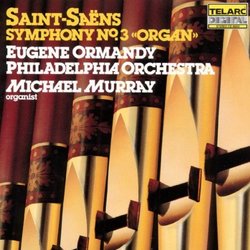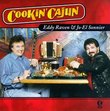| All Artists: Camille Saint-Saens, Eugene Ormandy, Philadelphia Orchestra, Michael Murray Title: Saint-SaŽns: Symphony No. 3 Members Wishing: 0 Total Copies: 1 Label: Telarc Release Date: 10/25/1990 Genre: Classical Style: Symphonies Number of Discs: 1 SwapaCD Credits: 1 UPC: 089408005121 |
Search - Camille Saint-Saens, Eugene Ormandy, Philadelphia Orchestra :: Saint-SaŽns: Symphony No. 3
 | Camille Saint-Saens, Eugene Ormandy, Philadelphia Orchestra Saint-SaŽns: Symphony No. 3 Genre: Classical
![header=[] body=[This CD is available to be requested as disc only.]](/images/attributes/disc.png?v=15401716) ![header=[] body=[This CD is available to be requested with the disc and back insert.]](/images/attributes/disc_back.png?v=15401716) ![header=[] body=[This CD is available to be requested with the disc and front insert.]](/images/attributes/disc_front.png?v=15401716) ![header=[] body=[This CD is available to be requested with the disc, front and back inserts.]](/images/attributes/disc_front_back.png?v=15401716) |
Larger Image |
CD DetailsSimilar CDs
|
CD ReviewsA sturdy "organ and orchestra" classic, in splendid sound. Bob Zeidler | Charlton, MA United States | 09/14/2003 (4 out of 5 stars) "The Saint-Saëns Symphony No. 3 ("Organ Symphony") is without question the most famous, and most frequently-performed, work in the symphonic repertoire for this pairing of forces. Over the years, it has received the attention of many conductors. A quick search of available recordings shows that most speciaiists in the French repertoire have committed performances to disc: Charles Dutoit, Charles Munch, Georges Pretre, Andre Cluytens, Paul Paray, Jean Martinon, Sir Thomas Beecham, Yan Pascal Tortelier, Jean Fournet, Michel Plasson, Louis de Froment, Louis Fremaux (some of them with multiple recordings). But, for all that "French specialization," the all-time record for most recordings of this work is held by a Hungarian, Eugene Ormandy. The record (no pun intended) shows that Ormandy and the Philadelphia Orchestra recorded this work at least four times: twice with E. Power Biggs (the first of which, in the mid-'50s, is how I first came to know the work), once with Virgil Fox, and, finally (almost as a "career summation") with Michael Murray on this splendid Telarc CD. Recorded at a time (1980) when Ormandy was preparing to relinquish his Philadelphia Orchestra Music Director position to his successor, Riccardo Muti, and when the novelty of digital recording was still unique enough that Telarc, in the vanguard of this technology, succeeded in securing recording rights for several major U.S. orchestras (including three of the "big five" if only for a limited number of releases), this performance is the equal of any, and the sound (from an unusual venue for the Philadelphia Orchestra, the St. Francis de Sales Church) remains "state of the art" nearly a quarter-century later. It is, arguably, one of the very best recordings of the Philadelphia Orchestra ever made, irrespective of repertoire. And the Cavaillé-Coll organ installation at St. Francis de Sales is a "near-twin" to the instruments actually played countless times by Saint-Saëns in Paris (at Notre Dame and at the Madeleine church). Saint-Saëns was both a child prodigy and a composer who lived, and composed over, a long and fruitful life. But he was "only" fifty when he wrote this final symphony of his; all of his subsequent works were in different genres. He thought it a fitting capstone to his symphonic output, and who are we to argue? Composed in 1888, when Johannes Brahms was the leading symphonist of the day and such young "upstarts" as Richard Strauss and Gustav Mahler were beginning to gain attention, Saint-Saëns's compositional aesthetic for the work (save for the fact that it incorporates the organ) is almost "reactionary" by comparison. It is immediately accessible to virtually anyone, such is its appeal. An adjective often used to describe Saint-Saëns's writing in this work is "suave"; I think this characterization is spot-on. The Philadelphia Orchestra has rarely if ever sounded better than it does here. Famous for its "silky strings" during Ormandy's tenure, the whole orchestra is a model of refinement so vital for realizing the suave writings of Saint-Saëns; all choirs of the orchestra exhibit this refinement at every dynamic level. The organ-orchestra balances are perfect (clearly, Telarc did a remarkable job in establishing these balances in what is often a tricky venue, that of a rather reverberent church). And the dynamic and frequency ranges of the recording are nothing short of astounding; of present-day "demo" quality despite the passage of a quarter century. My only complaint about this CD - and it is admittedly one that is "pocketbook dependent" - is that it offers rather a small amount of music for its cost. When it was newly-released (as a fairly early Telarc CD transfer from a 1980 digitially-mastered LP), matters were different, and CDs offering significantly more playing time than this one does were the exception. Nowadays, with 75+ minute CDs a routine matter, this recording - good as it is - should either be remastered to include more music (not a problem, given Telarc's large catalog), or offered as a "super budget" reissue (also not a problem, since Telarc has such a product line). This is the ONLY issue that keeps me from giving this recording a 5-star rating. For interpretive and sonic reasons, it clearly deserves such a rating; it remains the best recording of this work after all these years. Bob Zeidler" The Philadelphia Sound, Writ Large John Grabowski | USA | 05/14/2001 (5 out of 5 stars) "If you've heard about the legendary "Philadelphia Sound" (which was killed by Riccardo Muti) and wondered what it was about, then get this CD. Many of the old Columbia (now Sony) recordings were made under less-than-great circumstances, and were mixed and equalized for the sound systems of the day (1950s and 60s), so they tend to sound strident and harsh and "gray." Many younger folks wonder what the big deal was over the so-called "Philadelphia Sound." Well, this CD should explain it to them. EO and the Philly Orch are lush without ever becoming bloated or "sugary." There is an intense spirituality at times, which betray Ormandy as a deeper conductor than he is often credited as being. This is probably the closest one can come to knowning what it was like to hear the Philadelphia Orchestra live back in those days, though the acoustic is more reverberant than one would get in the dry Academy of Music. In fact, perhaps it is a bit too reverberant. That would be my one slight reservation with the CD. There are some parts that are a little covered-over and smeared. It's only minor however, and there's nothing that would stand in the way of my recommending this disc. Be forewarned it's not a very long CD, and it wasn't even by CD standards when it was first released. But there's quantity and there's quality, and I'd rather have the latter." How can I add to these reviews? Christian Ellithorpe | Streamwood, IL United States | 10/10/2004 (5 out of 5 stars) "So many reviewers here have said it so well, that I'm unsure I can say it any better, but I will try. I can pay no higher compliment to this performance by Ormandy, the Philadelphians and Telarc than to say, that this is the ONLY performance that is as perfect and as moving as the Charles Munch/Boston Symphony Orchestra RCA performance from 1959. That CD has the well-earned status as the benchmark of perfection in performance, even after forty years. I've probably owned a dozen recordings of this symphony and this is the one I invariably come back to, along with the one by Charles Munch. However, this one is so splendidly recorded, I believe it is an essential recording. Ormandy gives one of his last & greatest performances, and the Philadelphians clearly want to leave him a legacy, pulling all of the emotional depth present in the Munch/Boston/RCA release. Murray proves why he has earned so much respect as an organist & interpreter of French Organ repertoire. This recording is a little unique in that the recording space sounds quite large, and it has a little more reverberation than most, but Telarc did a magnificent job in being able to pick up so much detail. I cannot say enough about the detail of the woodwinds they achieve while still capturing the Philadelphia Orchestra's famed string (and brass) sections. The only possible way it could be any better is that the fast piano runs in the last scherzo are just a tad more faint than in most recordings due to the reverberation & recording space, but that is an EXTEMELY minor flaw compared to the richness of detail found all over this recording. The adagio of this symphony alone is worth the price of this disc. Ormandy, like Munch plumbs the depths of aching, of deep longing & the eventual ecstatic peace that make the adagio as admired as anything written by Mozart, Bach, Beethoven, Brahms or Mahler. I really believe that any of them would have been deeply moved if they heard this peace, and of course Mahler certainly did, and must have admired it deeply! Saint-Saens himself admitted, sincerely & quite humbly, after finishing this symphony, that he could do no more. He had achieved perfection, and Ormandy, Murray & the Philadelphians have paid tribute to Saint-Saens by doing the same."
|

 Track Listings (2) - Disc #1
Track Listings (2) - Disc #1